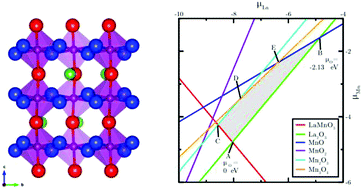Modelling oxygen defects in orthorhombic LaMnO3 and its low index surfaces
Abstract
LaMnO3-based perovskites, which have been extensively studied as cathodes for high temperature solid oxide fuel cells (SOFCs), are also of interest for intermediate temperature SOFCs (T = 600–1000 K). Oxygen vacancy formation is required in LaMnO3 for oxygen diffusion, therefore a low vacancy formation energy is preferable. The stability of the low index surfaces of orthorhombic LaMnO3 has been investigated, with the {010} surface found to be the most stable. Surface stability was found to be affected by the La and Mn coordination, and the Mn–O bonds cleaved on surface formation. The crystal morphology has been predicted, in order to determine the most likely terminations to be present. The formation of oxygen vacancies in bulk LaMnO3 and at all of its low index surfaces has been examined, and it has been found that formation of vacancies in the bulk has a high energy, while there is a large variation in formation energies at the low index surfaces, which is likely to lead to segregation of vacancies to the surface of orthorhombic LaMnO3.



 Please wait while we load your content...
Please wait while we load your content...